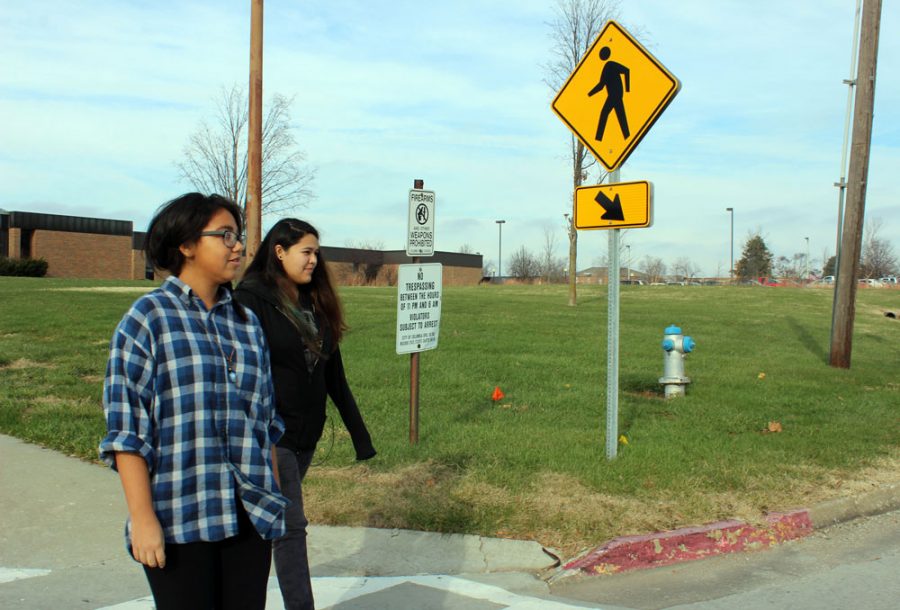Sophomores Amanda Andrews and Emily Caranza wait to cross the street during school. Several students have recently taken more concern for their safety.
The PedNet Coalition, a pedestrian safety organization based in Columbia Missouri, suggested the implementation of a program called Vision Zero to city officials on Oct. 17. The program originates from Sweden and envisions a world with no pedestrian deaths from car accidents.
“At present, Columbia does not have a Vision Zero program or policy like New York City, Seattle and a dozen other cities,” City council member Ian Thomas said. “If we should adopt Vision Zero at some point in the future—possibly after the Mayor’s Task Force on Pedestrian Safety makes its recommendations—we would be setting a goal of eliminating traffic deaths and serious injuries.”
The project, if implemented, would focus on spreading awareness and physical changes to the roads. The physical changes include reducing speed limits, the widening of roads and making the interval for traffic lights dependent on pedestrians instead of cars. As far as public communications, the program stresses subjects like the dangers of texting and driving.
There were 4,735 deaths in 2015, according to the Governor’s Highway Safety Association. In the past year and a half there have been eight pedestrians have been killed or injured in Columbia. The PedNet coalition hopes that the possible implementation of Vision Zero will bring the body count down even more.
“Not only will a successful Vision Zero program improve safety in Columbia, but it will also encourage more people to walk and bicycle for some of their essential journeys, because the streets will be safe,”Thomas said.
Junior Lisa Zhuang runs the risk of being struck by a car nearly every day when she runs and walks for leisure and to get to class in the career center. While Zhuang is careful and, to some extent, fearful of drivers’ abilities to stay focused and keep the road safe, she does believe that Columbia is helping ease those concerns, especially around schools. Zhuang would support Vision Zero if it was put into place, but she wishes more people shared her support.
“I feel that road improvements are important, especially in certain parts of town where I don’t feel quite safe on the road design. However, I feel that the education aspect is more important,” Zhuang said. “Currently, a lot of information about road safety is kind of taught in one big chunk if it is taught to students. It is definitely a good idea, although I feel as if not enough people are informed of it.”
While sophomore Lauren Hofmann agrees that pedestrian safety is important and changes to the roads would provide that safety, she notes that Vision Zero would also come with a disruption of traffic. Hofmann believes that once traffic is more pedestrian-led, its pace will decrease and busy students like her might not have extra time to spend.
“… I live far away already. It takes me 15 minutes to get to school even if there’s not traffic,” Hofmann said. “I probably would have to leave for school really early if these were implemented.”
Despite the challenge this would create for Hofmann, she still sees its benefits for herself and others. These benefits are especially crucial to teenaged Hofmann., Every day six teens, like Hofmann, will die in a motor vehicle accident, according to the Center for Disease Control
“It’s important to understand that the goal of Vision Zero is to eliminate all traffic deaths and serious injuries…[such as] pedestrians, bicyclists, drivers, transit users, etc,” Thomas said. “For some reason, we have accepted that traffic deaths are inevitable when in fact, with proper road design, legal enforcement, and community education, they’re not.”
Categories:
Organization introduces new project, drives to improve street safety
December 13, 2015
0
More to Discover













































































